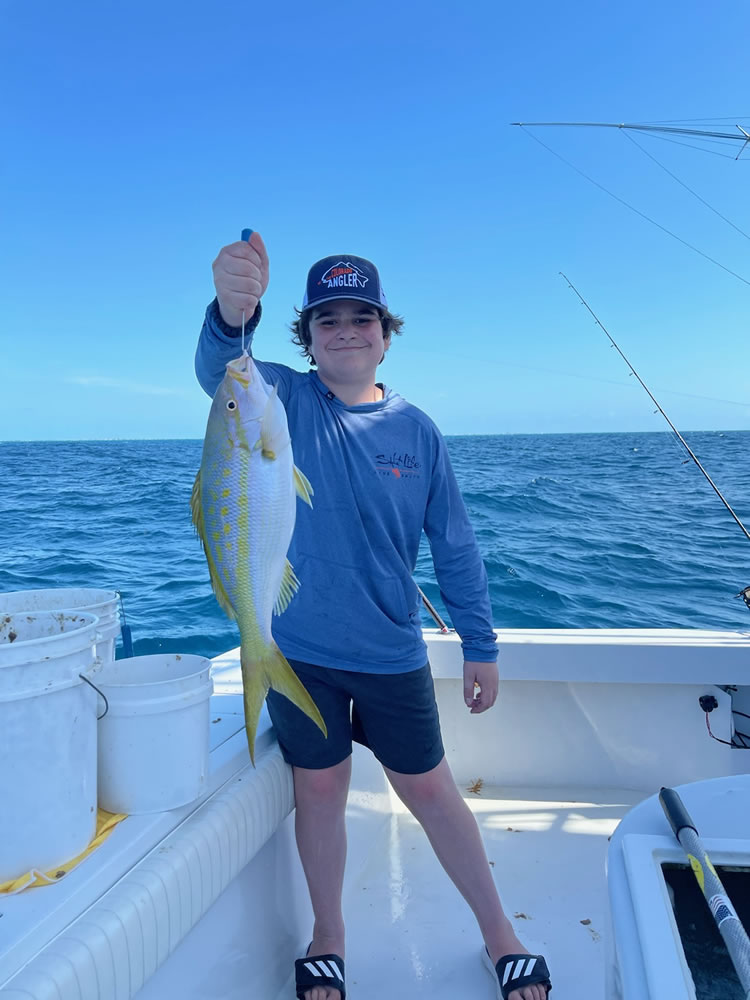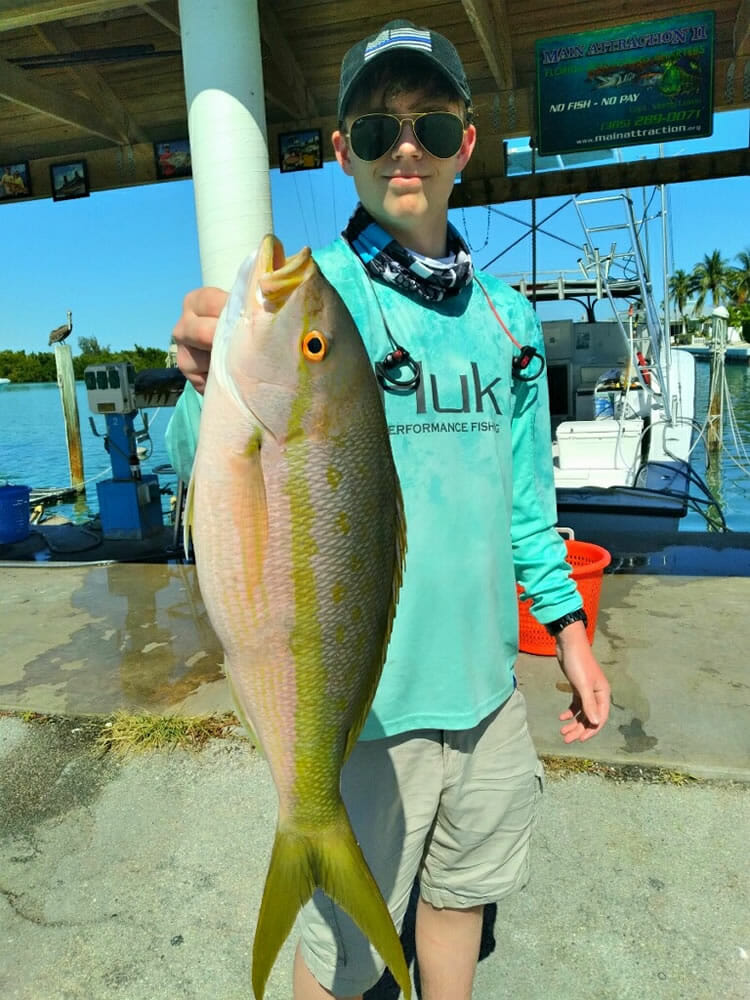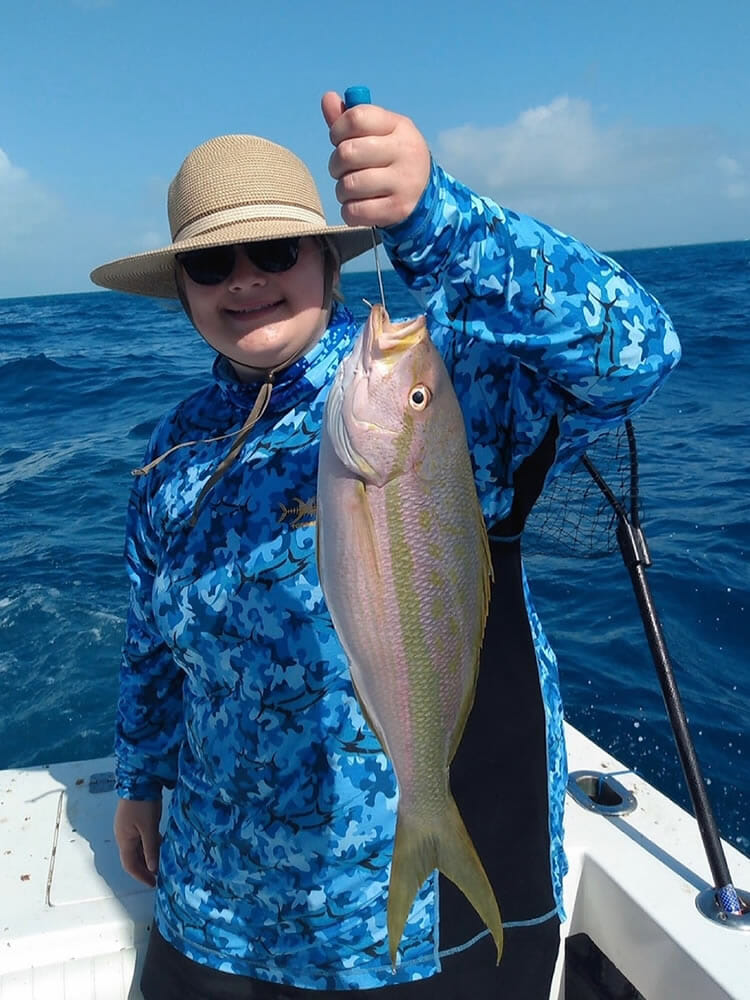The “Secret” to Successful Yellowtail Fishing Trips in the Florida Keys
Here in the Florida Keys, one of the most sought-after fish to catch on the Reef is the Yellowtail Snapper. People love them because you don’t have to travel very far to catch them and they are delicious to eat!
Another bonus of Yellowtail fishing is that since they are smaller fish, we use light tackle to make the fight fun and challenging. These lighter rods are much easier to handle making this fishing style universally compatible with anglers of all ages and skill levels.
When the conditions are right, some days the fish are practically jumping in the boat, but not always. Yellowtail Snapper can at times present challenges for Captains and Mates, and having our customers aware of this is advantageous to everyone involved.
Yellowtail Snapper can be tricky to catch because they have a lot of pressure on them in the Florida Keys. This is because, between commercial fishermen and charter boats, Yellowtail Snapper are fished for every day of the year.
Because Yellowtail never get a break from being targeted, the conditions play a major role in how we must fish for them to catch them consistently. If you are simply looking for a short article with quick tips on what bait to use or fishing line see our Yellowtail Snapper Fishing in the Florida Keys article.
The purpose of this article is to discuss in-depth the various factors that will play a major role on the success of your Yellowtail fishing trip.
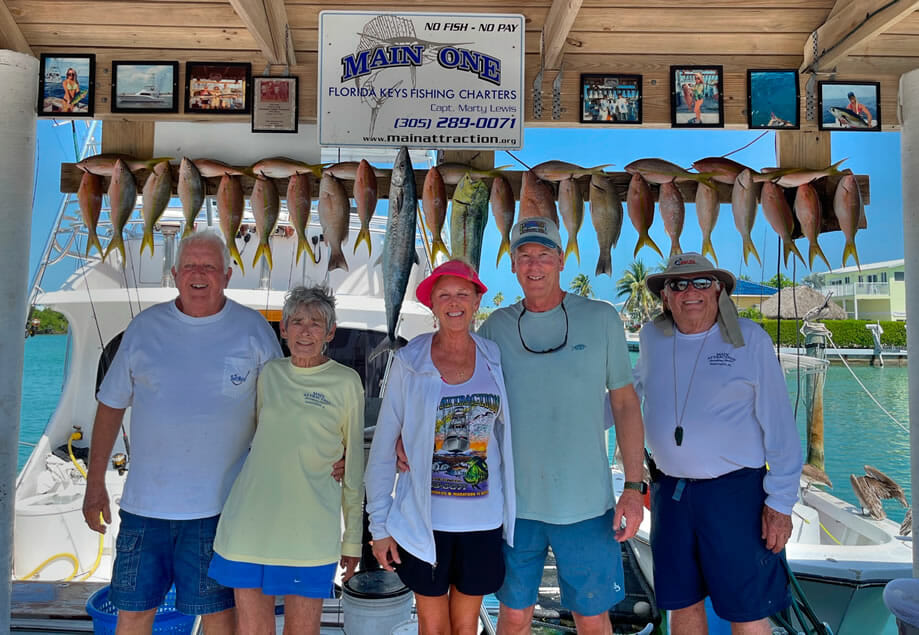
Mr. Cookie and the rest of the 7th Street KCB crew with a nice rack of reef fish!
Wind and Current Direction
On a calm, sunny, crystal-clear day, everyone gets excited for a beautiful day on the water free of seasickness (hopefully!). However, on days like this, if our crew has a reef trip booked, they know they will have to work extra hard to get the Yellowtail to bite. There are several reasons why this is, and two of them are the wind and current.
East Wind
Typically, in the Florida Keys, the current runs from the east to the west on the reef, unless the gulf stream is in close which can change things. In the Spring and Fall, the wind often blows from the east as well. When a boat anchors, the wind blows the boat along the surface of the ocean until the anchor rope tightens.
This means boats face into the wind and the rope runs from the bow of the boat to the anchor. If the current is heading west and the wind blows out of the east this is wonderful. Why? Because it means the current will take the chum on a path directly behind the boat. We fish off the back of the boat so ideally, we want our fishing lines, hooks, and baits drifting behind the boat along with the bits of chum the fish are eating.
This is how we catch Yellowtail snapper. Once they are in the chum slick comfortably eating bits of fish, we drift back a light line with a very small hook and a piece of bait that looks just like the other bits of chum they have been safely eating.
This is why we usually chum the water for 10-15 minutes to get the fish eating comfortably before even thinking about drifting back lines.
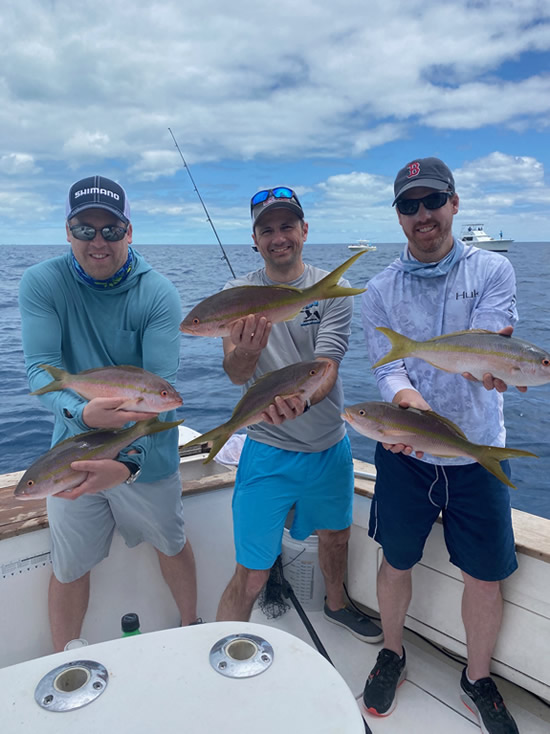
Some days the yellowtail are practically jumping in the boat!
North Wind
The wind does not always blow out of the east. In the wintertime, it often blows from the North or North East, but this is also good. This just means that often the current is running behind the boat but also sometimes off the side of the boat which still works for us.
If the current is running off the side of the boat, the Captain can bridle the boat which means he cleats the anchor line to one of the sides of the vessel causing the boat to spin a bit and allow the lines to drift with the chum behind the boat.
If the conditions do not allow the Captain to deploy this technique safely, the group can simply fish fewer lines to avoid tangles.
North winds bring cooler air, higher wind speeds, and choppier seas. Since the island of Marathon is to the north of the reef, it offers fisherman some relief as it absorbs some of the north wind’s energy.
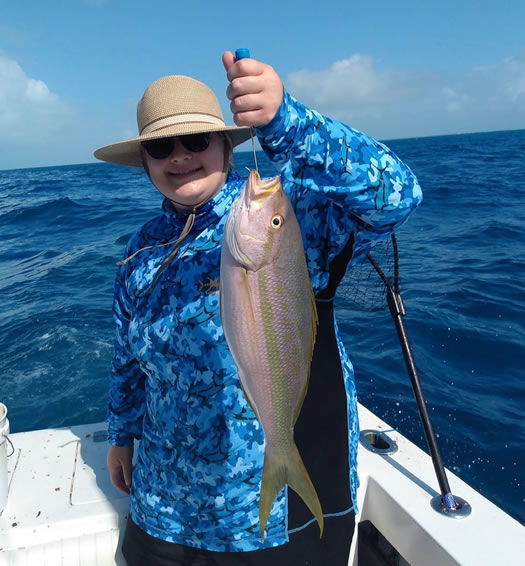
Northerly winds bring cooler air and choppy waves in the winter, but they also bring a good Yellowtail bite.
South Wind
In the summertime, the wind often comes out of the south or southeast. We do not fish for Yellowtail as much in the summertime since it is Mahi Season and that is what most of our clients wish to do this time of year.
Also, it can be quite calm in the summertime and there are many days where there is not much wind at all. That can make for some hot conditions to be anchored on the reef in the summertime. In July, during the Mangrove Snapper spawn, we will hit the reef early in the morning while it’s still cool and catch very large Mangrove Snappers before heading offshore to look for Mahi as the temperature rises.

Miss Sally and Captain Marty Lewis with a Mangrove Snapper, a great alternative to Yellowtail Snapper in July.
West Wind
On rare occasions, the wind may blow from the West which can cause some very unpredictable fishing. We jokingly say “When the wind is from the west, stay home and rest.” That being said, there have been some outlier days when we were fishing in tournaments with a wind out of the West and did phenomenally well. That’s the thing about fishing, you never really know what’s going to happen until you get out there and give it a go.
When it comes to Yellowtailing however, a wind from the west is often going to mean an opposing current which is far from ideal.
Up The Rope
Whenever the current is moving against the wind, we call that “up the anchor rope” and that is far from ideal. This means that the current is taking the chum, fishing lines, hooks, and baits all to the front of the boat where we cannot fish for safety reasons.
In this scenario, the fish are all off the bow of the boat instead of the stern causing all sorts of challenges that result in tangles, broken lines, lost fish, and undetectable bites. On days like this, your Captain might suggest other fishing styles such as Wreck or Offshore. If this happens, rest assured your Captain is not trying to upsell you, he is simply giving you an alternative that will likely produce better results that day!
Wind Speed
The speed of the wind and current are also very important factors that our Captains and Mates need to consider when they take you Yellowtailing. If wind speeds are higher as we typically see in the winter, this can be quite good for Yellowtail fishing. Larger waves and a disturbed surface often fire up the fish into a feeding frenzy. If there is a lot of wind the boat might swing from left to right which can cause tangles and snags on the bottom which your Captain and Crew will be aware of.
While the fishing can be great in these conditions the downside is that some customers can get seasick as the boat rocks on anchor. This often puts us in a difficult position if we are dealing with a party that wants calm waters perhaps because there are children, or elderly, or those prone to be seasick in their party, but also has high expectations for catching many fish on the Reef.
We also have no control of the weather and can only rely on predictions to make these judgment calls. This is why our customers must check in with us the night before their trip so we can inform them of the predicted weather and what to expect.
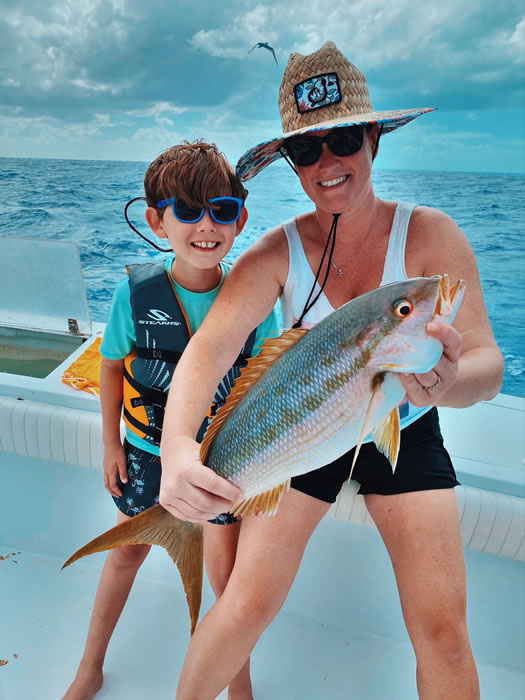
Katie Lewis warned Mindy and Parker that the winds would be high for this Yellowtail trip last month, but they decided to tough it out and it paid off with some great fish!
Current Speed
The speed of the current can present its own set of challenges when it comes to Yellowtail fishing although these are more surmountable than issues with wind speed or current direction. Ideally, we want a steady current that keeps the chum slick moving at a decent pace that brings the Yellowtail off of the bottom somewhere in the water column where we can usually see them.
When there is a lack of current the chum tends to float downwards causing the schools of Yellowtail to ball up down toward the bottom. In this scenario, all anglers must not only sense the bite quickly but must also wind fast to get the yellowtail up and off the bottom before they swim into the rocks and chaff or cut the line. Yellowtail love to eat rolled oats and your Captain or Mate might hide a bait in the center of an oatball to sink it to the Yellowtail if there is a lack of current.
If the current is very fast the chum slick might be far behind the boat and require long drifts to hook them. In this scenario, we may deploy oatballs to sink the baits to the schools of Yellowtail if the current is moving so fast that our baits are stuck near the surface.
Long drifts far behind the boat also present a challenge because the further the line goes out the more weight there is, which causes the fishing line to peel off the reel quickly. When the line flies off the reel like this it looks like a bite, which can trick both amateurs and experienced anglers to reel the line in before they even reach the fish.
Long drifts also allow the notorious filefish an opportunity to nibble your bait off the hook before you even reach the Yellowtail. In the winter it is not unusual for a toothy critter like a Mackerel to come by and take the bait during a long drift. This can result in a confused angler when all they reel in is a fishing line without a hook.
Sunlight and Water Clarity
It is a natural behavior to want to go fishing on a beautiful sunny day in the Florida Keys. But if your goal is to catch loads of fish on the reef you might want to consider going when the weather is a bit rougher. You may overhear your crew saying that the water is “dirty” or green, if you do, that is great news for reef fishing! The “dirtier” the water, the less the fish will see the line, which means we can fish more lines at a time. This is one of the reasons we fish for Yellowtail Snapper so much in the wintertime, because the higher winds, bigger waves, and overcast skies reduce the clarity of the water helping camouflage our lines and allowing us to have more rods in people’s hands.
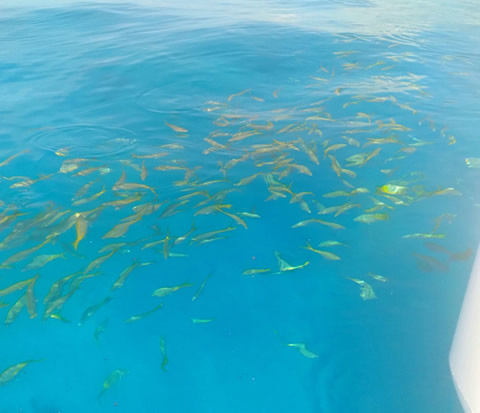
With some effective chumming and a little luck, sometimes you can get the yellowtail so comfortable they are right behind the boat!
Sunny skies and calm weather make for beautiful crystal-clear waters that the Yellowtail snapper can see the fishing line quite easily in. As mentioned earlier, since they are fished for so hard, they know exactly what that line means, DANGER! This causes the Yellowtail to become very skittish and reluctant to bite. To combat this our Captains and Mates will generally move to an even lighter fluorocarbon leader to make it harder for them to see the line. Unfortunately, a lighter fishing line means it is easier to break the line and lose the fish.
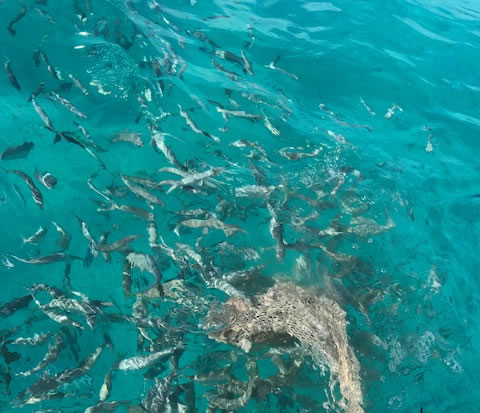
Some days there will be a gauntlet of other fish you don’t want between you and the Yellowtail. Oatballs can help you get past them!
For this reason, our crew does not immediately cast a fishing line in the water after they anchor up. If they were to do that, they risk spooking the Yellowtail and ruining that spot for the trip. They wait an appropriate amount of time while chumming to get the fish cozy first. They start with one line at first to see if they can get a bite. If the bite is good and the fish are comfortable more lines will be added. If the Yellowtail are biting well it’s game on and the crew will let the customers catch all the fish they can. If the customers lose a few fish the bite can slow down sometimes. If the bite slows down our crew will take some lines out of the water so as not to spook the fish. If the bite stops completely all lines will come out of the water and the chumming process will start all over again.
Our crew will sometimes try and hook the first few fish if they suspect conditions might make it difficult. They are doing this because they are trying to assess the situation, not take away your fun! Sometimes we get comments like “there was 6 of us but only one line in the water”. We understand why that might be hard to understand but when it comes to Yellowtail Snapper putting 6 lines in the water will result in spooked fish and tangles.
Sometimes we get feedback after a tough reef trip where a customer might say, “I didn’t have a rod in my hand enough” or “the Mate was hooking the fish for me”. You might watch our team members fish for a while as they try and figure out current speed and direction, and get the fish comfortable enough where you can start catching them consistently. It is our job to catch fish and sometimes, it means one line at a time until those fish are happy.
Remember If you are bored of waiting for the bite to warm up or don’t understand why a Captain is taking a certain approach, please communicate this with them! They will always be happy to explain their process, make adjustments, or even try something else if you prefer.
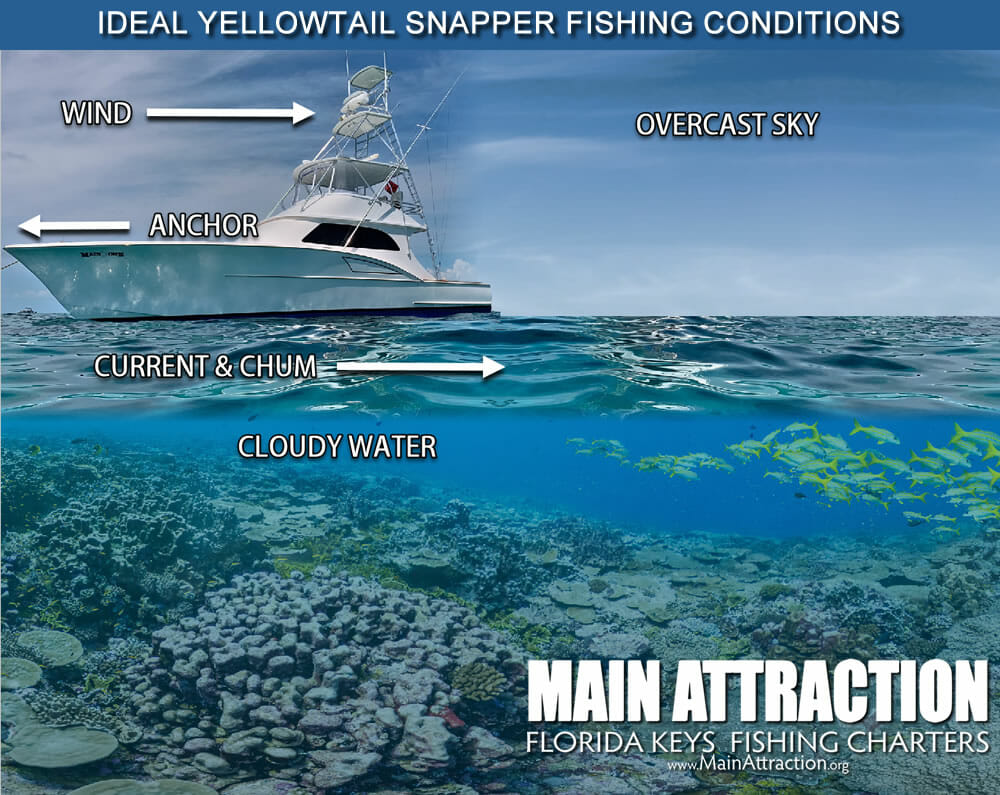
While this graphic shows the ideal scenario for Yellowtail fishing in the Florida Keys, not all factors need to align to catch Yellowtail!
Fish Size
Yellowtail Snapper vary in size from tiny to as large as 10lbs. The younger ones live in the shallows and are quite easy to catch, but these are illegal to keep. The legal ones are a little further out on the reef and harder to catch. By law, we can only keep Yellowtail that are at least 12 inches to the fork of the tail (at the time of writing this article). A bit deeper, only during certain times of the year, very large Yellowtail that we refer to as Flags are biting, and these can be very tricky to catch.
When you go Yellowtailing with us chances are you will start at a fishing spot that has Yellowtail in the 12–18-inch range. Once you and your group have some dinner in the box and show the crew you can wind fast, if the big ones are around, your Captain might give you the option to try a much more challenging spot and target some Flag-sized yellowtail.
A Yellowtail Snapper doesn’t get big by being dumb, so naturally, the larger ones will be far more challenging than the smaller ones. You will likely lose quite a bit of them if it’s your first time, but they are very satisfying to catch when you get the hang of it. Flag yellowtail can be over two feet long and are worthy of getting mounted for your wall!
Each vessel is equipped with the best equipment and tools necessary to ensure a successful trip, however, we cannot control the bite or the weather. You may have your heart set on big Flag Yellowtail but if they are not biting, trying to target them would be a waste of time. You must fish for what is biting, not what you want to be biting!

Captain Aaron holds up a flag sized Yellowtail Snapper.
The Learning Curve
The light 12-15lb fluorocarbon leader we must use to get Yellowtail to bite sometimes leads to lost fish.
Anglers must wind fast enough so their Yellowtail does not run into the rocks and chaff the leader till it breaks, or get eaten by a predator before making it to the boat. On a handful of occasions, we have had customers assume they were losing fish because our knots were to blame! We assure you our crews are all well trained, experienced fisherman that are amazing at tying knots seeing as they do it thousands of times a year.
Unfortunately, losing fish can slow down or even shut down the bite at a given spot. If the conditions look tough initially, the crew members might hook some fish and hand off the rod to you until you get the hang of it. Once the Yellowtail seems comfortable in the chum slick, or at least you have some dinner in the box, the crew will hand you the rods to try hooking them yourself.
Even experienced anglers that are unfamiliar with Florida Keys fishing can have trouble with Yellowtail as they have developed habits and muscle memory from targeting other species.
When it comes to Yellowtail fishing, we simply leave the bail open and drift the bait back in the current with all the other bits of chum. When the line starts flying off the reel you close the bail keep the rod pointed at the water, wind like heck till you come tight, and then slowly lift on the rod. At this point, you lower the rod back down as you quickly wind up the slack and repeat the process.
Countless times we have had experienced anglers try to set the hook as a bass fisherman would. While it is entertaining to watch we assure you it is quite unnecessary and often results in jerking the hook or bait right out of the fish’s mouth.
Even when it comes to the same species, catching a Sailfish in Mexico is nothing like catching a Sailfish in the Florida Keys. The same goes for Yellowtail Snapper. Different areas have different fishing techniques developed for good reason; the surrounding environment has a significant impact on a fish’s behavior and proven techniques cater to those behaviors.
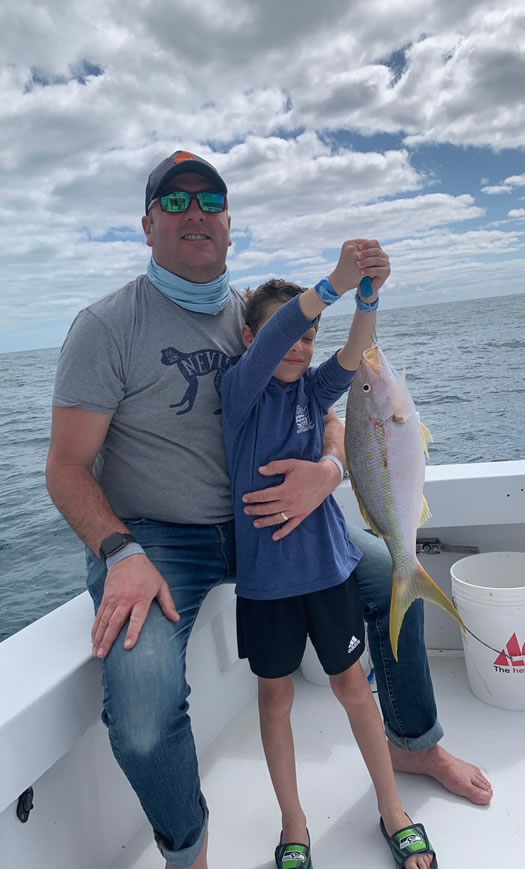
With a little bit of help and guidance even young people can wind in a good sized Yellowtail!
The Importance of Communication
At the Main Attraction, we work hard to maintain a great reputation and we understand happy customers are the key to our success. We go out of our way to be accommodating and want you to have a wonderful trip. From the very start of the booking process communication is the key to a great trip.
When you first book your trip, you will speak with Co-Owner Katie Lewis. As an experienced angler that knows Florida Keys Fishing, Katie is a great fit to be your first point of contact. Katie will do her best to find out what your goals are for the trip, along with which vessels you are interested in. Feel free to ask Katie questions as she is knowledgeable about the vessels as well as the fishing seasons.
Our Captains fish every day so they generally know what’s most likely to be biting based on the previous day, weather patterns, and fishing conditions. In addition to this, Katie will relay to the Captains what she has learned about your goals for the trip.
Trips often have 4-6 individuals on the vessel each with their own personality, level of experience, and goals for the day. For this reason, when you step on the boat you should still discuss with the Captain what your options are and make it clear what the goals for the trip are. Based on all of this information the Captain will do his best to determine what type of fishing you should be doing.
Your Main Attraction crew has been trained to keep you involved in your trip, explain what is going on, and not make any assumptions on your skill level. If you feel they are overexplaining everything because you are experienced feel free to let them know. Conversely, if you wish to know more about what a Captain or Mate is doing at the time, simply ask them. Our crews love to talk about fishing if you give them the chance. If you are unsure why a particular technique is being used, ask them.
While we are well-known for catching tons of fish because that’s what we do, it is still fishing. You are not guaranteed to absolutely crush it every time you come out fishing with us. Just as the article discusses in detail, many factors will impact your success.
As with anything in life if you come in with overly high expectations you simply set yourself up for disappointment. At the Main Attraction, we especially appreciate our customers that get on the boat hopeful for an awesome catch but mainly to have fun.
Most importantly, if you are not having fun, if something is wrong, PLEASE tell your Captain immediately. Give him a chance to make a change and save the trip. If for any reason you do not want to speak directly to the Captain about the issue, call Katie Lewis even while you are on the vessel so she can address your concern and fix it right away!

With a great attitude and some teamwork you are bound to have a great time on the water!
Conclusion
In summation, reef fishing in the Florida Keys is some of the best fishing in the country if not the world. Yellowtail Snapper are delicious, fun to catch, and highly sought after in the keys. It takes experience, knowledge, and flexibility to catch them consistently. Even with knowledge and experience, sometimes the conditions of the day will ultimately dictate whether you catch a lot of Yellowtail or not. The secret to a successful Yellowtail trip is for the crew and customers to have great communication and work as a team toward a common goal. Additionally, if your goal is to have fun, you are setting yourself up for a better time than if your goal is just to get meat.
Whether you are looking to tackle Yellowtail fishing on your own or come out with one of the awesome crews at the Main Attraction, we hope this article was helpful, educational, and interesting to read! As always if you have questions or feedback, please feel free to visit our contact page or call us at (305)-289-0071.

